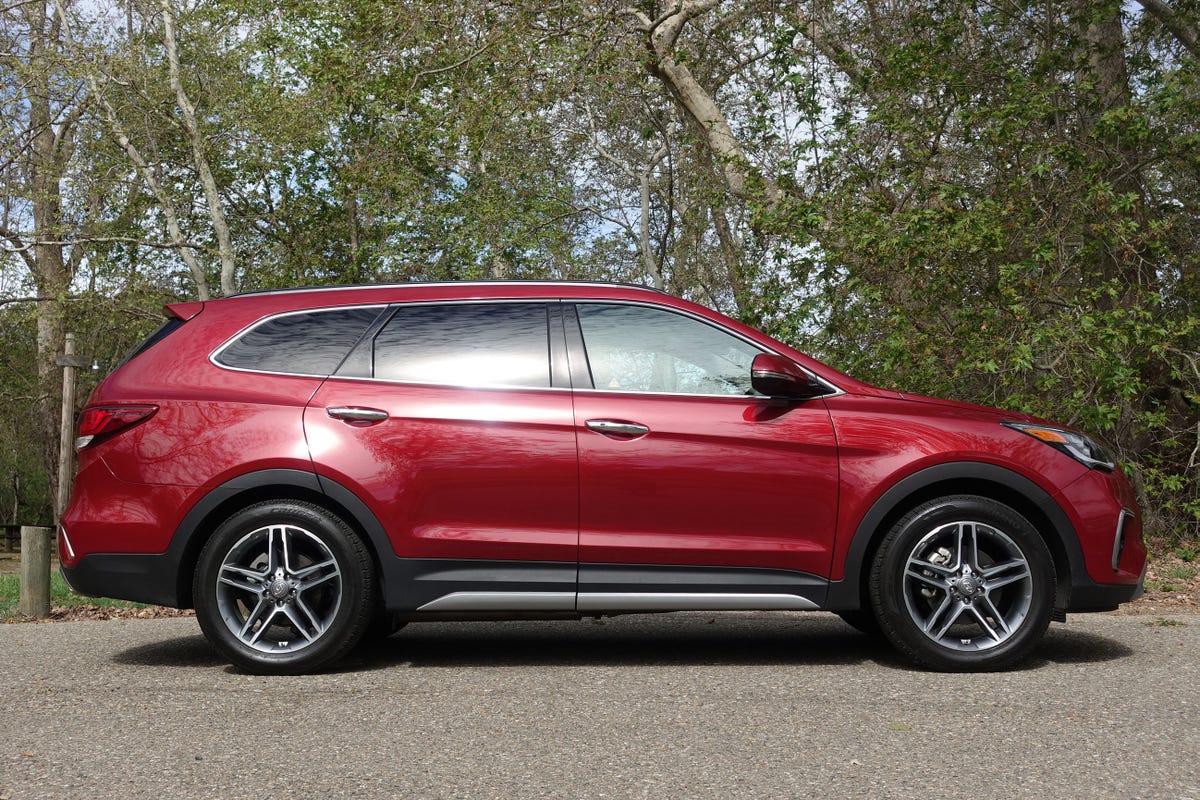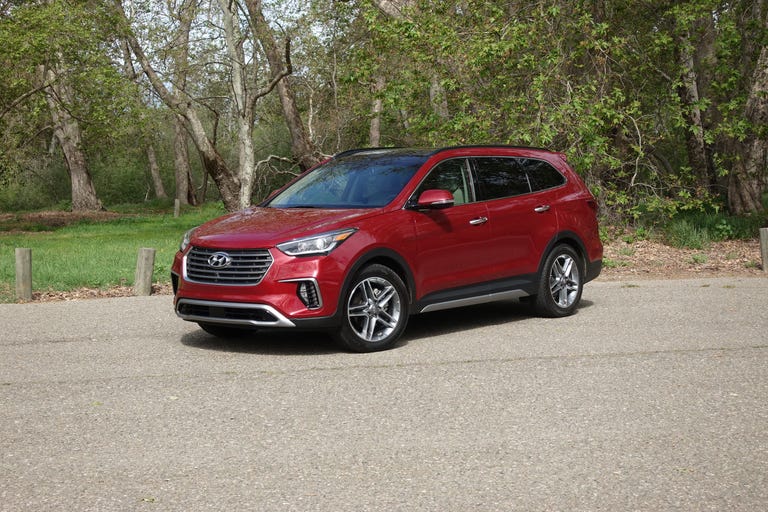 Why You Can Trust CNET
Why You Can Trust CNET 2017 Hyundai Santa Fe review: 2017 Hyundai Santa Fe: Your SUV prom date got a new dress
Sure, the Santa Fe has been around for a loooooong time, but the refreshed model for 2017 brings the dependable seven-seater into today's style.
A few years ago, a pal asked for some car-buying advice. She needed something big, and as a self-employed handbag designer and crafter, it had to be affordable. Even though I hadn't driven it at the time, I recommended the Hyundai Santa Fe. The three-row crossover SUV had enough space for her to haul goods to market, and it gave her a lot of bang for her buck.
The Good
The Bad
The Bottom Line
Fast-forward four years, and I've finally had the chance to drive the big Hyundai, both on a long, boring drive down Central California's San Joaquin Valley, and then on some stunning twisty roads from the valley to the coast. Turns out, my pal got everything she wanted, plus a whole lot more.

Check out the new rocker panels. Fancy.
Hyundai's Santa Fe isn't America's best-selling three-row SUV. That honor goes to the Ford Explorer. In fact, it's not even the second- or third bestseller on the list, with the Toyota Highlander, GMC Acadia and Chevrolet Traverse all pulling ahead of this Korean offering in terms of sales numbers for 2017. But remember, folks, sales numbers don't tell the whole story. I found the Hyundai Santa Fe to be a comfortable ride with easy-to-manipulate tech and surprisingly sporty handling that belies its family footprint.
New for 2017 are updated front and rear fascias that bring a more modern look to the stalwart three-row Santa Fe. The biggest change up front is a new headlight design, with available high-intensity discharge headlamps as well as revised available LED daytime running lights and fog lights. The rear gets more square-shaped LED taillights and a new design for the dual exhaust outlet. Also new for this year is an updated rocker panel design along the sides, now with silver accents, and new alloy wheels. The changes are not drastic but they are noticeable, and they help push the newest model to a more modern design aesthetic.
The Santa Fe Sport is a smaller, two-row crossover that is treated as a separate model. You can read our review here.
Bring on the power
The Santa Fe comes with a 3.3-liter V6, good for 290 horsepower and 252 pound-feet of torque. That's enough grunt to accelerate quickly and smoothly, with plenty of power while merging onto the highway or climbing up and over hills. I was surprised at the way it handled the twisties through the hills outside of Pismo Beach. Let's just say I was struck by a bathroom emergency and had to squeeze every bit of road-hugging grip out of the available all-wheel-drive chassis on my way into town. With a minimal amount of body roll, I barely had to lift for the long, sweeping corners and the Santa Fe responded to sharper turns with a quick steering response, snappy downshift from the six-speed automatic transmission and swift acceleration out.
Hyundai gives us a well-appointed cabin in the Santa Fe.
This year's Santa Fe gets a drive mode selector, with the options of Normal, Sport and Eco. It's located to the lower left of the steering wheel, which is let's say, an awkward location. Each mode will adjust throttle, transmission and steering response. Eco definitely makes the Santa Fe feel more like a desert tortoise, with quick upshifts and a lazy throttle, but it was tough to tell the difference between Normal and Sport.
But let's face it. Most Santa Fe buyers aren't going to be driving like a bat out of hell to the next rest stop. They'll be more interested in the interior, where the Santa Fe does not disappoint. Hyundai has really upped its game in recent years when it comes to material quality and construction. Despite being a few years old, this cabin is well put together, and my top-of-the-line (weirdly named) Limited Ultimate model arrived nicely appointed, with leather, heated and cooled front seats, heated rear seats and a nifty panoramic sunroof.
The Santa Fe's seating is super-comfy, even on a droning 6-hour drive down California's I-5. The second row slides forward and back to give easier access to the third, and they even recline for a quick rest-stop nap. The third-row seats are fine for kids or small adults, but anyone with a bit of height and an average American waistline will find them uncomfortable -- bigger rivals like the Chevy Traverse have more room. However, you can distract yourself with no fear of draining your phone's battery, as the third row has a USB port. Thanks, Hyundai!
Hyundai's infotainment system is easy and intuitive, and it's compatible with Apple CarPlay and Android Auto. The available eight-inch touchscreen offers clean graphics and is quick to respond. A new 360-degree camera system is standard on all but the lowest trim line, offering a bird's-eye view that's helpful when parking in tight spaces.
Standard on the Santa Fe is the Blue Link package. Just connect your car to your smart phone and you have access to all kinds of features like remote start and climate control and remote lock/unlock. You also have access to emergency and roadside assistance. Combined with Hyundai's 10-year/100,000 mile warranty and the Santa Fe is not only connected, it's also reliable.
Pow! Big grille in your face.
Blind-spot warning with rear traffic alert and lane change assist are all standard across the line, save for the lowest trim level. The first time the blind-spot warning went off, it was so loud as to jolt me out of my seat and nearly through the panoramic roof. Fortunately, you can turn off the audible alert and just leave the visual cue on the side mirrors. And don't confuse lane-change assist for lane-keep assist. Hyundai's system tells you if it's safe to change lanes by measuring the speed of the approaching vehicle in the next lane, but it won't actively keep you from changing lanes.
Lane departure warning is part of a $2,100 tech package that also includes adaptive cruise control with stop/start functionality, automatic emergency braking and automatic high-intensity discharge headlights that turn along with the steering wheel. The package is worth it if you commute in heavy traffic, as the adaptive cruise control takes away a ton of stress. The system stays engaged while stopped for a good three count. More than that, and a simple tap on the gas gets things going again. Some manufacturers' adaptive systems don't work at low speeds (I'm looking at you, Honda). This one does, and it's great.
The only box the Santa Fe doesn't tick is cargo space. The 13.5 cubic feet of space behind the third row is much smaller than the 21 offered in the Ford Explorer. Fold those seats down, and that space increases to 41 cubic feet, which is about in-line with the Toyota Highlander. Behind the first-row seats is 80 cubic feet, which is dwarfed by the 116 cubes on tap in the much larger Chevrolet Traverse.
EPA fuel ratings are 17 miles per gallon in the city, 22 mpg on the highway and 19 mpg combined, though those numbers improve a bit on lighter front-wheel drive models. However, my average for a week's worth of driving, including my 900-mile road trip, was a whopping 24.9 mpg.
LED taillights? Don't mind if I do.
Since my designer friend bought her Santa Fe, she's quit her day job and now has a successful custom leather handbag business. Could it be that my advice, and the value offered by the Santa Fe, changed her life? I like to think so.
The 2017 Hyundai Santa Fe starts at $30,800 and my top-trim Limited Ultimate with all-wheel drive, the tech package and destination charge comes to $44,295. While the Santa Fe may not be the first in your mind when it comes to a three-row SUV, it definitely deserves a test drive. Maybe the Santa Fe would change your life, too.


